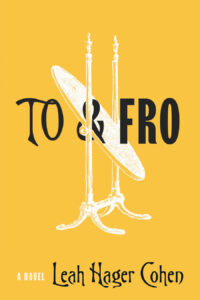
On the Joys of Following Literary Instinct Wherever It Leads
Leah Hager Cohen Asks: “Can anything compare to the wonder of being lost?”
A few miles from my home lies a 175-acre garden cemetery full of hills and glens, groves and clearings, fountains and ponds and winding footpaths. The layout is such that no matter how often I go walking there, the place remains capable of bewildering me. Suddenly I’ll come around a curve to experience the pleasure of finding myself somewhere other than where I’d expected.
Occasionally I’m able to slip my bearings altogether and for whole seconds turn in place before recalling in which direction the entrance lies. How fatly the birds trill then, how sharp the air tastes. In these moments before reorienting myself, the world reveals itself as giddily, lavishly alive. Can anything compare to the wonder of being lost?
*
Some years ago I sat in the back of a packed lecture hall where a well-known novelist read from her latest work. Responding to an audience question about how she constructed her plots, she revealed that she never wrote so much as a single word of a book until she’d mapped its complete outline.
Often I have despaired of my ineptitude as I struggle to chart the rough waters of storytelling or find my way out of narrative doldrums.
Alas, I thought. So much for me.
I’ve never been one for making outlines. It’s not that I’m resistant—well, scratch that: I am, I’m highly resistant. But I have tried, despite my resistance, to determine from the outset the course a book should take. I just seem incapable of working that way.
*
There’s an exercise I do with creative writing students. I call it Paper Bag. Everyone gets a brown paper lunch sack with an object inside. The idea is to reach in (no peeking) and feel around for the hidden thing. “Try not to worry if you don’t know what it is,” I tell them. “In fact, if the know-it-all part of your brain is saying, ‘Hey! I can name that object!’ gently invite it to shush. Knowing won’t be helpful for this exercise. Knowing will get in the way.”
I encourage them to explore their object slowly, pouring their attention into the strangeness of blind touch. I ask them to trace the object’s contours with one hand while mirroring the motion with the other, almost incidentally gliding a pencil across a blank page as they do. “Don’t worry about what your drawing looks like,” I tell them. “Give yourself over to feeling. To not-knowing. What are you able to notice, to discover, in this way?”
They swap bags and reach in again, locating the new item with their fingers. We move from drawing to writing prompts—lists of adjectives, then free associations, then invented backstories—swapping bags between each. We finish with an act of literal discovering: students remove the mystery objects from their bags one by one and hold them up for all to see. Oh, a guitar pick! Oh, a pistachio nut! Oh, a birthday candle!
The more intriguing discoveries lie in what the students have written: the unexpected fineness of their tactile observations, the surprising gems their imaginations have brought forth.
*
The Blind Fumbling approach to making art does not guarantee unmitigated delight. Every semester, in my students’ reflections, I read about the frustration and anxiety Paper Bag provokes in them. I can sympathize. As someone apparently constitutionally incapable of writing except without knowing where I’m going, I’ve been similarly vexed. Often I have despaired of my ineptitude as I struggle to chart the rough waters of storytelling or find my way out of narrative doldrums. Nor has the challenge grown easier with time. My latest novel, To & Fro, proved the most daunting yet. Never have I shed so many tears over my own obtuseness or berated myself so fiercely over what seemed the unforgivable limits of my creative intelligence.
Not that it started out that way. It began in the spirit of madcap, playful glee. Inspired by a Kafka parable called (ironically enough) “My Destination,” the first part unfolds in a world of no-set-time and no-set-place. Much to my own amusement, I found myself setting off after a girl who’s set off after a man who’s set off after a sound no one else can hear.
For a while I went along in much the same vein as I like to meander through the beautiful garden cemetery near my home: without a predetermined route, alive to whatever I happen to encounter, led in equal measure by curiosity and chance. I didn’t mind that I had no idea where any of us were heading—not the man, nor the girl pedaling after him on a bicycle, nor the stolen kitten she for some reason brings with her, nor, for that matter, me. I didn’t mind until suddenly I rounded a corner and found myself—nowhere. Perched on a shallow, crumbly ledge with nothing before me but a terrible abyss.
Never have I shed so many tears over my own obtuseness or berated myself so fiercely over what seemed the unforgivable limits of my creative intelligence.
I lost courage then, and stopped writing for several months.
*
When next I picked up the pen, what unspooled was a different story about a different girl in an altogether different world: contemporary Manhattan. This girl had no kitten, no bicycle, no man to pursue. And yet soon I felt her to be in dialogue with the girl from the parable world, and before long I had gone back to work on that story, too. Back and forth I wove, noticing that certain objects—a leatherbound notebook, a mirror, a coin—cropped up in both narratives, as did a common fascination with language, and with messages, and with the limits of what can fully be communicated.
Both girls’ journeys were underpinned by a kind of yearning so strong it was like conviction, a kind of lonesomeness that fueled a preternatural determination to make contact. And I could feel them, these two girls who did not know, who could not know, that the other existed, reaching toward each other blindly, with something like openness, something like faith.
When the tête-bêche form—that is, printing two texts upside-down to each other in a single volume and starting them at opposite ends of a book with two front covers, so that they meet in the middle—first occurred to me, I was quick to dismiss it lest it seem gimmicky. But as the book grew, this structure came to feel essential. Upon completion, as one mainstream publisher after another turned it down, I let myself be convinced to rewrite the novel in a more conventional manner, braiding the two girls’ stories into one. However, this version appealed to no one, least of all me.
Alas, I thought, when it seemed the novel was destined for nowhere but a desk drawer. This is what comes of setting off without a roadmap.
That was when the manuscript—in its conventionalized form—found its way into the hands of Erika Goldman at Bellevue Literary Press. That she offered to publish the book after it had accumulated so many rejections felt miraculous. That she stipulated, without any knowledge of my earlier intention, she’d publish it under the condition that I separate the two narratives and we print them upside-down to each other, starting at opposite ends of a book with two front covers was nothing less than jaw-dropping. Erika’s ability to see into the soul of the book was like a manifestation of the kind of deep recognition that my two young protagonists, each on her own fumbling, fervent, mapless journey, seek.
*
The funny thing about getting lost—coming face to face with the limits of our own capabilities—in a cemetery is that it’s redundant. A cemetery is, by definition, full of concrete reminders of that which we can never hope to grasp. If each grave marker is a monument to someone who once lived, collectively they are a monument to the ultimate unknown: the ineffable, that which we might guess at, but which will never be revealed to us in this-set-time and this-set-place.
We might apprehend it only through its tracings, through birdsong and turtles plopping off logs and the sugar-sharpness of an early spring breeze. Through allowing ourselves to wander without knowing where we’re headed and, if we are lucky, through the invigorating ecstasy of sometimes finding ourselves lost.
__________________________________

To & Fro by Leah Hager Cohen is available from Bellevue Literary Press.
Leah Hager Cohen
Leah Hager Cohen is the author of seven novels, including To & Fro, and five works of nonfiction, including Train Go Sorry. Among other honors, her books have been longlisted for the Women’s Prize for Fiction, named a finalist for the Dayton Literary Peace Prize, and selected as best books of the year by the New York Times, Washington Post, San Francisco Chronicle, Globe and Mail, Christian Science Monitor, and Kirkus Reviews. Cohen is the Barrett Professor of Creative Writing at the College of the Holy Cross. She lives in Belmont, Massachusetts.



















